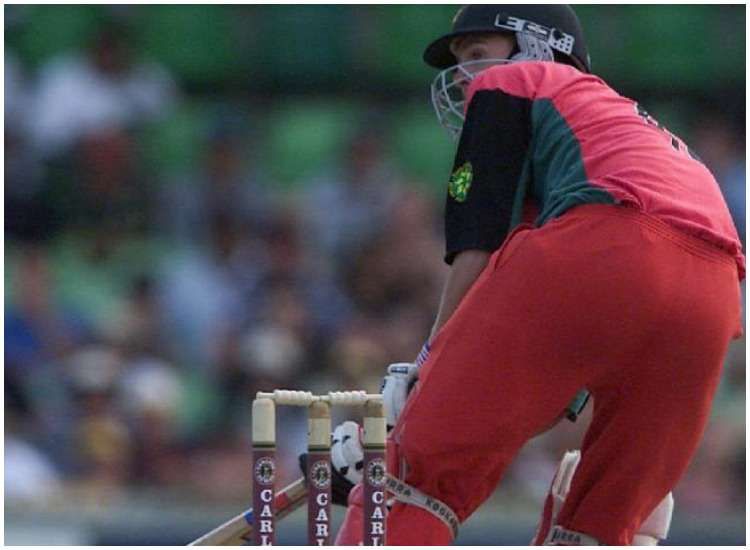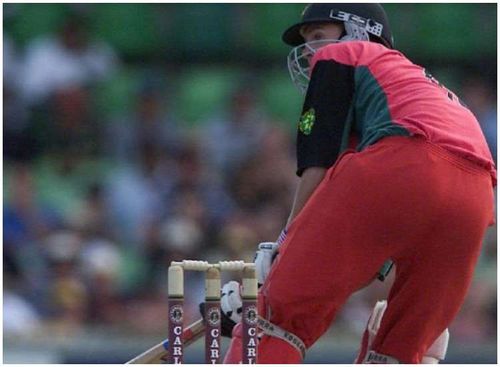
SK Demystifies: Douglas Marillier's trend-setting scoop shot

“Change is the only constant in life.” Greek philosopher Heraclitus’ immortal words can encapsulate cricket’s existential fabric. From chinaman to reverse swing to doosra, bowling has undergone a fascinating transformation over the years. Not to be left behind, batsmanship has also overseen an equally enthralling metamorphosis over the course of time.
From reverse-sweeps to scoop shots, there has been no shortage of innovation in the game. In the latter facet, plenty of variations such as Dilscoops, switch-hits and reverse-scoops have emerged. However, the credit for designing the original stroke goes to Douglas Marillier. Zimbabwe’s forgotten all-rounder was the one who came up with an interesting response to manoeuvre the leg-side field.
Extra Cover: SK Demystifies – Saqlain Mushtaq's doosra
The shot, which has become an integral part of the modern-day limited-overs batsman’s burgeoning repertoire, can offset a captain’s well-laid plans. The major reason behind the scoop’s efficiency stems from the prevailing restrictions in field placements.
Since the controversial ‘Bodyline’ series of 1932-33 between Australia and England, the lawmakers modified the rules to prevent a repeat of the episode. With only two fielders (apart from the wicket-keeper) allowed in the quadrant behind square on the leg-side, the scoop or ramp shot is a viable option if the targeted part of the field is up during the death overs.
Usually seen against the quicker bowlers, the batsman uses the bat as a ramp and guides the ball beyond the head of the man at short fine-leg. The secret to executing the stroke with precision lies in using the pace on the ball. The ball has to land between the good length and full length areas so that the batsman can get underneath it.
The scoop gains extra significance if the bowler errs in length and sends down a low full-toss. Such instances are quite common in the current era as pacers struggle to nail the yorkers. If a spinner is involved, the shot contains a semblance of risk as the ensuing turn can often result in outside-edges. Once the batsman accounts for the turn, such a ploy becomes a useful option in the middle-overs as well.
The origin of the scoop shot
Even though Marillier would later go on to admit that the stroke was accidentally envisaged during an ODI against New Zealand at Taupo, the first famous instance of the scoop shot came during the 2001 Carlton Series. In what was a thrilling ODI between Australia and Zimbabwe at Perth, he captivated the spectators during the final over of the game.
In pursuit of 303, Zimbabwe rode on a 187-run partnership between Stuart Carlise and Grant Flower to put pressure on the hosts. With the equation coming down to 15 runs off the last six deliveries, Marillier stunned Glenn McGrath by dispatching two low full tosses to the square-leg boundary.
Getting into an adequate position before the seamer could deliver the ball, the right-hander scooped the ball past the wicket-keeper and short fine-leg fielder as if he was using a scooper to serve ice cream. Even though the Aussies eked out a nervous one-run victory, his cheeky invention was etched in the memory.
Marillier’s moment in the sun
Marillier’s moment in the sun came during an ODI against India at the Nahar Singh Stadium in Faridabad in 2002. By then, he had almost perfected the scoop shot and was waiting to unleash the wily weapon.
Chasing 275 on a weary track, Zimbabwe looked down and out when they were reduced to 210/8. But Marillier pulled off one of the most audacious rescue acts in recent times to leave the Indians in utter disbelief. Premeditating with consummate ease, he repeatedly turned the bat into a ramp and smashed a 24-ball 56.
Singling out Zaheer Khan for his daring heist, the right-hander sent the ball flying on either side of the wicket-keeper’s head. Shell shocked by the ingenuity of the shot, the left-armer did not have any suitable riposte. Plagued by a no-ball crisis, the pacer lost his radar and kept playing into the batsman’s hands.
Marillier‘s unbeaten half-century helped Zimbabwe complete a nerve-wracking one-wicket triumph. However, he could not quite build on the remarkable knock and managed only 48 ODIs in his brief career. Little did he know of the trend that his scoop shot would set in subsequent times.
Executing the perfect scoop shot
The scoop shot or the ramp is a premeditated attempt at converting a seemingly decent delivery into a productive one. Particularly handy in the business stages of ODIs or T20s, the vital aspect of executing it properly stems from flexibility at the crease.
Upon not being inclined towards either foot, the batsman has to position himself in such a way that he can quickly shuffle across the crease. The next part lies in anticipating the bowler’s plan and picking up length much quicker than expected.
While the right foot moves along a straight line parallel to the stumps, the body weight is transferred in one motion. On the other hand, the left foot has to be positioned so as to maintain a stable base.
Extra Cover: 5 unorthodox cricket shots behind the wicket
At the point of meeting the ball, the batsman bends accordingly and looks to get underneath it. The precise part between the middle and bottom of the bat comes into play. Since significant momentum is generated at the instance of making contact, it becomes important to find the right elevation. Without attempting to overhit the ball, timing the shot to an optimum level leads to the desired result.
If implemented properly, the scoop shot can send the ball flying past the short fine-leg fielder and garner crucial runs at key moments in the game. As cricket continues to evolve, the innovative stroke is rapidly turning into a go-to option for batsmen who seek to gain the upper hand in limited-overs formats.
